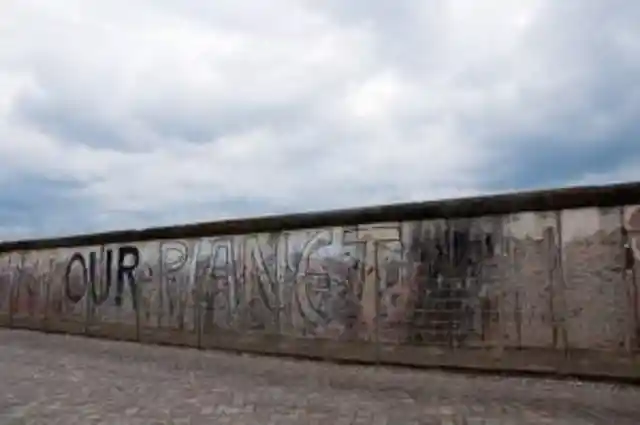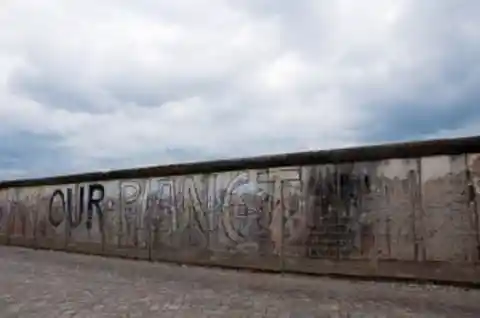The Beginnings Of The Berlin Wall
The Berlin Wall might be one of the most famous structures ever built, mostly because of what it represented. Its fall in 1989 was a historic triumphant moment for the West’s victory over communism in Europe. But what isn’t so well known are the decisions that resulted in its construction, and how it actually came to be. Here’s a primer on how and why the wall came into existence, including some obscure facts.


At the end of World War II, Germany found itself split into four “allied occupation zones.” The eastern part of the country went to the Soviet Union, while the remaining three zones comprising West Germany went to the United States, France, and Great Britain.
Berlin, situated technically in East Germany, was also split, with the Soviet Union taking East Berlin. On a daily basis, about a half-million people moved between East and West Berlin, a situation that caused its fair share of problems as East German residents were able to compare living situations with residents of West Germany.
In June 1948, an Allied airlift impeded a Soviet blockade of West Berlin; during the next 12 years, millions fled East Germany; by 1961, the exodus included a daily total of about 1,000 skilled laborers, intellectuals, and professionals. On August 12, 1961, the largest number of defectors – around 2,400 individuals – left East Germany. In response to the mass exodus, construction of the Berlin Wall began the next day.
Temporary borders were set up to separate east from west, asphalt and cobblestone roads were torn up, and plans to construct a concrete and barbed wire wall were set in motion. The effort was called “Antifascistischer Schutzwall,” indicating the wall’s true purpose: to keep Western fascists out, and thereby stop them from undermining the socialist state.
The official explanation for the wall’s construction was to “put a stop to the hostile activity of West Germany’s and West Berlin’s revanchist and militaristic forces, border controls of the kind generally found in every sovereign state will be set up at the border of the German Democratic Republic, including the border to the western sectors of Greater Berlin.” In truth, however, the wall was constructed to stop the defections.
During the next few weeks, construction of the wall included replacing the barbed wire with hollow blocks and concrete slabs. Completion of the wall required integrating rows of houses as well as sidewalks into the structure. The East German government required that the houses feature bricked up ground floor windows and front entrances so that the single entry point of each house was located in the courtyards situated in East Berlin.
The Construction Of Checkpoints
Several checkpoints along the wall were established and named Charlie, Alpha, and Bravo. Checkpoint Charlie, located on the Friedrichstrasse, was the only gateway for Western diplomats, military personnel, and foreign tourists to enter East Berlin. On October 22, 1961, Checkpoint Charlie was the site of an incident between an East German border guard and an American heading to the East Berlin opera; the altercation led to a tense face-off between Soviet and American tanks that stretched on for 16 hours.
The Allies, too, stationed military police at the wall checkpoints, but with different goals in mind: In addition to monitoring comings and goings, they provided information to travelers who were venturing beyond the wall. The Allied checkpoint presence was visibly less threatening than that of the East Germans, whose checkpoints included imposing guard towers and cement barriers. The East Germans also maintained a checkpoint shack where they could conduct heat scans to ensure that fugitives were not hiding in vehicles, and they also confiscated any texts containing information contradictory to communist beliefs.
Escapes Lead To Modifications
Over time, the Berlin Wall was modified and reinforced, and systems were put in place to help limit the number of successful attempts to leave East Berlin. In April 1962, Heinz Meixner, an Austrian, managed to bypass the Berlin Wall and smuggle his girlfriend and her mother across the border in a rented Austin-Healey convertible. How? He quickly and easily lowered the car windshield, and sped under the Checkpoint Charlie vehicle barrier. After another individual escaped in the same manner, the East Germans added steel bars to the checkpoint. In another attempted escape, Horst Beyer hopped across the wall while simply pretending to take conduct a photoshoot.
More than 100,000 East Germans attempted to cross the border and escape between 1961 and the fall of the wall in 1989. Of those, more than 600 were killed by border guards or died in other ways as they tried to make it beyond the wall. In addition to the wall structure, the area included elements designed to thwart escapes, including anti-vehicle trenches and beds of nails that came to be known as the “death strip.”